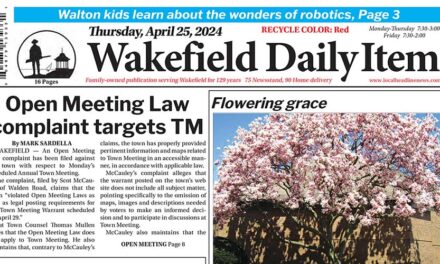By MARK SARDELLA
WAKEFIELD — It seems that there can be no discussion of the proposal for a senior living facility on Crescent Street without some kind of friction surfacing and last night’s Historical Commission hearing was no exception.
As expected, the commission invoked its power to declare a six-month demolition delay with respect to two Crescent Street homes that are listed as “significant sites” by both the Wakefield and Massachusetts Historical Commissions.
The homes, at 17 and 19 Crescent St., are among six residences on the street owned by the Fraen Corporation. Shelter Development is in the process of acquiring those properties as well as an office building at 338 Main St. Shelter would like to demolish all of the structures to make way for a 130-unit Brightview Senior Living facility.
Historical Commission Chairman Nancy Bertrand described 17 Crescent St. as a Federal-style building built before 1784 on its original location at the corner of Main and Summer streets before being moved to its present location around 1870.
She said that 19 Crescent St. was a Greek Revival structure built around 1840 and was likely the first house on Crescent Street.
Last night’s hearing was attended by a number of local residents interested in finding ways to save 17 Crescent St. in particular, which had once been the home of by Dr. John Hart. Hart is said to have been a Revolutionary War figure who served for a time under George Washington. Locally, Hart served as Town Moderator, selectman, School Committee member and State Representative.
Representing Fraen Corporation and Shelter Development, attorney Brian McGrail had filed the application to raze the structures. He introduced Shelter’s Director of Development Michael Glynn, who he said had driven up from New York for the hearing.
In response to questions from the commission, McGrail indicated that it would not be possible to preserve and incorporate the Hart House as part of the project as planned.
That didn’t sit well with one commissioner.
“They just don’t want to do it,” said Commissioner Gene Moulton. “It’s possible. They just don’t want to do it.”
McGrail said that Shelter was willing to work with the commission or anyone else who was interested in moving the homes and preserving them that way. Glynn confirmed that Shelter was willing to contribute funds up to $10,000 per house toward relocating the structures. McGrail added that if demolition does occur, Shelter would also commit to hiring an expert to document the homes and see what could be preserved that is of historic importance.
But Bertrand estimated that the cost of moving a house was closer to hundreds of thousands of dollars. She admitted that over the years the Hart house’s historic elements could have been modified.
The commission was receptive to a suggestion that they consult with the selectmen and perhaps form a committee to determine the cost of moving and preserving the homes and to determine what town-owned land might be available as a new location for the homes.
Water Street’s Bob McLaughlin blamed the town for allowing things to get to this point. He said that the Planning Board gave no consideration to the neighborhood when it recommended favorable action in creating the Assisted Living Overlay District.
McLaughlin said he was “appalled and disturbed” by the attitude of town officials for allowing neighborhoods and buildings to be destroyed. He said that the selectmen should be “shamed” into finding a way to move and preserve the homes. “They put us in this position,” McLaughlin said.
Moulton pointed the finger more at “developers from out of town,” accusing them of wanting to make Wakefield look like Melrose or Malden.
“They are not interested in preserving the historical part of the town,” Moulton asserted. “It all comes down to money and outsiders could really give a damn about the town.”
Spaulding Street’s Bob Mitchell, an opponent of the Brightview project, also did not mince words, calling the impulse to raze the homes on Crescent Street “un-American” and “a disgrace.” If he owned those homes, Mitchell said he would “rather slit my own wrists than see them destroyed.”
But local resident Patricia Murphy suggested that cost would make saving the homes impractical. She maintained that the expense of moving, rehabilitating and restoring just one of the homes to any kind of museum quality would be closer to $1 million.
Glynn was asked if Shelter would be willing to fund the cost of having a professional preservationist go through the homes in order to help the town determine if it was feasible to save them.
Glynn took the opportunity to say that he felt that some of the evening’s rhetoric against developers was directed at him.
“I’m pretty disturbed about some of the things that were said tonight about me personally,” Glynn said. “Why don’t we dial that back and we’ll be happy to collaborate.”
McGrail defended Glynn.
“It’s a testament to my client that he’s here tonight,” McGrail said, especially knowing that a demolition delay was all but inevitable. “The fact that he drove here from New York to hear what was said, I think, says a lot about him and his company.”




